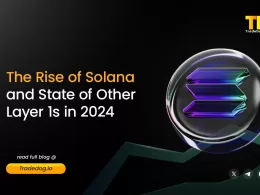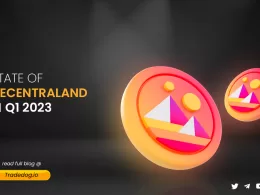Quick Links
Financial services, such as borrowing and lending, have become an integral part of our lives in various forms, such as car loans, business loans, and educational loans, as well as loans between nations. This market has tremendous potential for growth, with projected estimates of it reaching $8682.26 billion in 2023, which is a significant increase from its value of $7887 billion in 2022 as per the reports by Business Research.
Traditionally, the approach to lending and borrowing is facilitated by intermediaries like banks, credit unions or other lending companies and the process is highly regulated and time-consuming as it involves a lengthy approval process and strict eligibility criteria. Moreover, there is a lack of transparency in terms of interest rates, penalties etc as the lending process is under the control of intermediaries.
DeFi Lending and Borrowing
Decentralized Finance, or DeFi, has emerged as a solution to overcome the hindrances of traditional lending and borrowing systems as it follows a decentralized approach to lending and borrowing, thereby eliminating the need for intermediaries and enabling a more accessible and transparent financial ecosystem. They offer complete transparency in terms of loan terms, interest rates, fees, and penalties, which are all recorded on the blockchain and can be accessed by anyone. It enables lending and borrowing funds via smart contracts which are self-executing computer programs that automatically enforce the terms of the loan agreement.
Why Decentralized Lending?
(I) Permissionless: DeFi platforms are more accessible to users as anyone with an internet connection can participate in the lending and borrowing process without any credit checks or barriers to entry.
(II) Asset Agnostic: means users can lend and borrow a variety of digital assets, including cryptocurrencies, stablecoins, and tokenized assets.
(III) Transparency: The use of blockchain technology in DeFi lending provides a transparent and immutable record of all transactions, ensuring that all parties involved in a transaction have access to the same information.
(IV) Decentralisation: The system works on a peer-to-peer basis and makes it less susceptible to the risks and vulnerabilities associated with traditional lending systems.
(V) Programmability: Smart contracts enable the creation of sophisticated lending protocols that can automate the process of lending and borrowing.
Best DeFi Lending Platforms
DeFi lending and borrowing is one of the most popular use cases of the DeFi ecosystem and has witnessed explosive growth over the past years. We will explore some of the top DeFi lending protocols on the basis of TVL (Total Value Locked). It represents the total value of cryptocurrency locked in a smart contract and is a useful indicator for investors if they want to assess if the protocol is healthy and worth investing in. A higher TVL indicates more capital is locked in a protocol and is high in demand while a low TVL means lesser availability of capital, resulting in lower yields with respect to transactions.
Aave
Aave is one of the most popular DeFi lending protocols built on the Ethereum blockchain. Launched in 2020, the core product offered by Aave is lending and borrowing digital assets which allow lenders to earn interest on their deposits while borrowers pay interest on the borrowed amount. The interest rates are determined on the basis of market forces of demand and supply of that particular asset.
Another unique product offered is the Aave Flash Loans. These are uncollateralized loans that allow users to borrow funds for a very short period, typically less than a second. Such loans are usually used for arbitrage opportunities,i.e traders take advantage of price discrepancies across different cryptocurrency markets or exchanges.
For example, if the price of a particular cryptocurrency is higher on one exchange than on another, an arbitrage trader can buy the cryptocurrency on the cheaper exchange and sell it on the more expensive exchange to make a profit. The borrowers are required to repay the principal amount borrowed plus interest within the same transaction. However, they are a high-risk product and should only be used by experienced users who understand the risks involved.
The Aave protocol has also issued its native crypto token (AAVE) which can be used for a multitude of purposes. Firstly, the Aave token holders can participate in governance by proposing and voting for changes to the platform. Secondly, the tokens can be used as collateral to borrow other cryptocurrencies and stablecoins on the platform. Thirdly, they can be used by token holders to validate transactions, keep the network secure and earn additional tokens in return as rewards.
MakerDAO
Launched in 2019, MakerDAO is one of the first DeFi applications to witness significant traction. It is a decentralized autonomous organization (DAO) that runs on the Ethereum blockchain.
The MakerDAO ecosystem is composed of two ERC-20 tokens – MKR and DAI, where MKR is its native crypto token used for governance and risk management of the platform while DAI is the decentralized stablecoin created and managed by it.
The core offering includes the creation and management of stablecoin, Dai pegged to the value of US Dollars. It is designed to maintain a 1:1 peg with the US dollar and is collateralized by a range of digital assets, including ETH tokens and others. It can be used for a variety of purposes like the store of value, medium of exchange to facilitate peer-to-peer transactions, trading pairs on cryptocurrency exchanges and used as an asset in lending and borrowing deals in DeFi applications.
The protocol allows users to borrow the stablecoin, DAI, by putting up collateral in smart contracts. These loans are usually overcollateralized which means the value of the collateral is more than the amount borrowed to account for the rapid changes in the price of tokens. If the value of the collateral falls below the collateral ratio, then the collateral is automatically liquidated to repay the borrowed DAI.
As Maker Protocol is a DAO,i.e. It is managed by community holders who have voting rights to make decisions regarding the governance, operations like setting the interest rates, stability fees charged on borrowed DAI and future development of the organization.
Compound
Compound is another popular DeFi protocol used for lending and borrowing purposes built on the Ethereum blockchain. It allows depositors to earn interest on their holdings while providing easy access to loans to borrowers where the interest is subject to change based on market conditions and demand and supply for the particular assets. The lenders deposit their assets to the pool for borrowing purposes and in turn receive ctokens issued by Compound as a representation of the users’ share of the total pool of assets in the protocol.
Compound protocol has issued its native crypto token COMP used for governance purposes. The token holders can stake their tokens to secure the network and in turn receive additional COMP tokens as rewards.
Conclusion
In summary, while all three are DeFi platforms that allow for the lending and borrowing of cryptocurrency, they differ in their specific mechanisms and features. Compound and Aave offer variable interest rates, while MakerDAO offers a stablecoin pegged to the US dollar. Aave also offers the unique feature of flash loans, while Compound and MakerDAO do not.
FAQ
What is the best DeFi lending platform?
The best DeFi lending platforms are Aave, MakerDAO and Compound based on the total value locked.
What are DeFi lending protocols?
DeFi lending protocols allow users to lend and borrow digital assets without any intermediaries and are cost-effective.
What is the biggest crypto lending protocol?
Built on the Ethereum blockchain, Aave is considered one of the biggest crypto-lending protocols.
What is the best lending protocol on Polygon?
Aave is the best lending protocol on Polygon.













